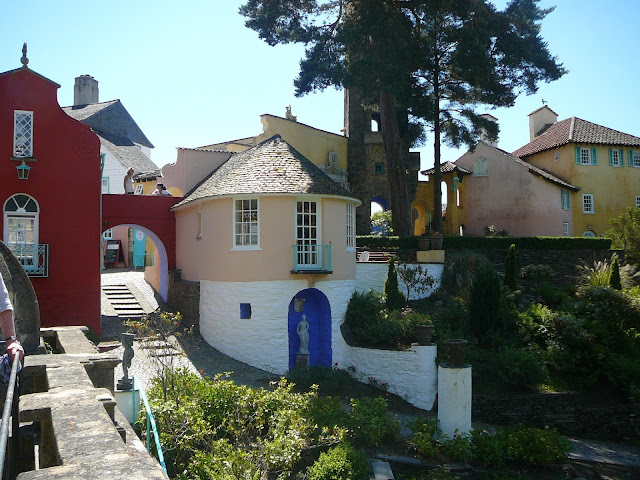Portmeirion
Portmeirion
"Port-" from its place on the coast; "-meirion" from the
county of Merioneth”, is described as a fantasy tourist village in Gwynedd,
North Wales; designed and built by Sir Clough Williams-Ellis between 1925 and
1975. It is full of Mediterranean charm, resembling an Italian village, (some say it was based on Portofino on the Italian Riviera), located 2 miles from Porthmadog, by the mouth of the River Dwyryd. It has been used as the location for several TV shows and films, including "The Village" in the 1960s show The Prisoner.
Many
celebrities visited Portmeirion, especially in its early days - such as Noël
Coward (who wrote Blithe Spirit while staying there), George Bernard Shaw and
H. G. Wells, Gregory Peck and Ingrid Bergman. The Beatles and their manager
were also frequent visitors, and George Harrison spent his 50th birthday there
and filmed interviews for a Beatles documentary. Portmerion sits on a private peninsular overlooking the coast, surrounded by the most beautiful scenery - with a very Mediterranean feel to it – a mixture between the Italian Riviera and rural Wales. The idea was to build a closely knitted coastal village with vibrant coloured and different architectural styles.
The colourful buildings include historical cottages, such as the "White Horse cottage", the "Mermaid cottage"; and "The Salutation" (which are now hotels, shops and eating places). In between these are quirky nooks and crannies, all which have been built around a central piazza, surrounded by gardens and extensive woodlands.
The Piazza is the most delightful place to spend time soaking up the atmosphere, you can enjoy the Bristol Colonnade overlooking lawns, ponds and fountains. Surrounding these lawns are colourful buildings with romantic sounding names – the Gloriette Balkon, Villa Winch, Chantry Row, the Pantheon and the Gothic Pavilion – to name but a few.
The
grounds contain some fabulous exotic plants especially
in the Japanese Garden (with its pagoda and lake) in a natural landscape, which
was established in the 19th century. During
Victorian times, former tenants planted monkey puzzle trees, pines, magnolias,
camellias, giant redwoods, as well as various rhododendrons. Even in the 20th century, planting of rare species continued, including up to 70 types of rhododendrons such as the red-flowering Portmeirion-bred cultivar rhododendron, known as the 'Gwyllt King', the magnificent magnolia campbellii with its enormous pink flowers and several ginkgo bilobas.
The subtropical forest known as The Gwyllt has some of Britain's largest trees, secret gardens, a derelict castle and rare flowers. Portmerions 70 acres contain 19 miles of paths through woodland and forests, with secret spaces (like the Dog Cemetery, tangle Wood, Ghost Garden and Shelter Valley) and paths down to coastal coves.
The
remains of a medieval castle Castell Gwain Goch are also in the woods just
outside the village, recorded by Gerald of Wales in 1188. Williams-Ellis
considered the Castell to be “the largest and most imposing single building on
the Portmeirion Estate", but when he purchased it in 1931 - it was in a
serious state of disrepair. With help from the Heritage Lottery Fund, the
European Regional Development Fund and the Wales Tourist Board, Castell
Deudraeth was opened as an 11-bedroom hotel and restaurant in 2001, 23 years
after Williams-Ellis's death. Castell Deudraeth has a restored Victorian garden
with lawns, flowerbeds and flowering trees.
Portmeirion
is now owned by a charitable trust, which uses most of the buildings as hotel
rooms or self-catering cottages. Parts of crumbling buildings and unwanted
artefacts were shipped in from all over the world to create what can be seen
there today; including loggias, grand porticoes and bright terracotta-roofed
houses.
The
village was built over 2 phases, (pre war) 1926 - 1939 and late from 1954 - 1976.
Most buildings were designed and built by Williams-Ellis but a few were bought
in from elsewhere; such as the Town Hall, the Bristol Colonnade, and the facade
of the Dome (which was originally known as The Green Dome - but this name was changed
when it was renovated in line with fire regulations in the 1990’s).
The
entrance is through the Triumphal Arch, and you can also see the Battery Square
with the quaintest souvenir shops.
You
can find out more about Portmeirion’s fascinating story in the Welcome Centre where
they offer a free 20 minute audio-visual tour of Portmeirion Village; also
during the summer season, you can take a complimentary train ride through the
Gywllt to the Oriental garden, where you will find a classic temple overlooking
the Chinese bridge and lake.
Whilst
I was at Portmerion, I took a walk down to explore the expansive sandy beach of
the Dwyryd Estuary which has more hidden caves, gullies and interesting plants
along the way. You can get an ice cream from Angel Ices Gelateria and soak up
the sun on this picturesque section of the coast or take a walk along the
coastal path to the end of the peninsula with stunning views of mountains as
well as the coast.
Overlooking the bay is the Portmeirion Hotel and the Amis Ruenis – a famous stone boat (a replica of one that was there in earlier times). I had the most delightful day exploring Portmeirion, I hope my photographs have given you an insight of what it offers.
For more information on visiting
this fascinating place please see https://portmeirion.wales/
Thank you for taking time to follow my adventures,
Lynne
These are my other blogs :-

























